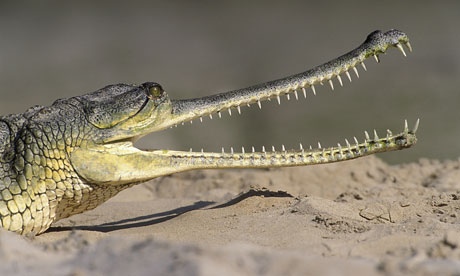
An Asian gharial at a crocodile farm in Pierrelatte, France. Conservation efforts on the Chambal river, in India, seem to be paying off. Photograph: AFP/Getty
My friend David has a real empathy for these reptiles.
"Do you know that they get gout too!" he says, amazed, as he nurses his sore foot and winces in pain, while we read a report about the mysterious deaths – seemingly from gout – of many of these reptiles. We wonder if the sick gharials also suffered from incredibly sore joints like humans experience from the disease, a form of arthritis.
Over four years ago, more than 20 gharials were found dead on the Chambal. They seemed to have been poisoned – dying from kidney failure and gout from eating contaminated fish from polluted rivers. "What a horrible death! Poor gharials," sympathises David, as we imagine the sick reptiles suffering.
But a few weeks later we hear some welcome news. The new breeding centre further up river, in the Sheopur district, is proving a success. More than 1,000 baby gharials from more than 40 mothers have hatched in the last month. On the drive back on the bus we talk to a few locals who are very excited about the gharial babies. One young boy tells me thousands have been born; a young woman tells me that there are tens of thousands.
Full Story
No comments:
Post a Comment